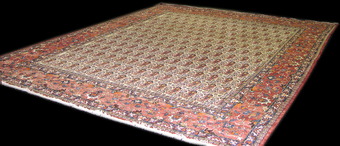Antique handmade oversized carpet No. 49368 Bakhtiari, ca. 1910 Iran 498 x 393 cm

Larger images (will open in new window)
Please click on the thumbnails below for a larger view
| main view |
 |
| Item Number: |
49368 |
| Name: |
Bakhtiari, ca. 1910 |
| Country of Origin: |
Iran |
| Size: |
498 x 393 cm |
| Made:
|
ca. 1910 |
| Pile: |
wool |
| Design: |
floral / allover |
| Ground Color: |
ivory |
| Remarks: |
This is a unique handmade / hand-knotted / traditional oriental carpet
The pile of this carpet is made of wool
Perfect condition, shiny silky wool.
The main element of this carpet design is the Botteh pattern, and in its smaller version: Mir design, in the West known as Paisley design. The Botteh motif is depicted in the shape of a teardrop and represents fertility and eternal life. It is often found in carpets from Kerman in Iran, India, and antique Caucasian rugs. The word Botteh comes from the Persian word for bush. |
 add to cart
add to cart
More about the provenance Bakhtiari, ca. 1910 | Iran
The name originates from the times when the landlords of the area were Bakhtiaris. Today Bakhtiari rugs are mainly made by peasants, therefore Bakhtiaris are not nomadic rugs as often mistakenly assumed. Bakhtiari rugs are of high uniqueness and durability.
This is an Oriental nomadic rug. The word "nomad" comes from the Greek word "nemein". Nomads are wandering tribes, shepherds, stockbreeders, or hunters. In the minorly populated areas of Asia and North Africa they move with their herds, all their belongings and their tents to new places constantly. Many states already tried to make them settle down with various success. Mostly it is the women of the tribes which contribute to the family's income with their carpet knotting and weaving while the men breed stock or go hunting. But due to the circumstances of nomadic life the carpet production often lacks regularity and precision in form and design, which actually adds to their originality and makes them even more popular. The wool is mostly dyed with vegetable dyes.

